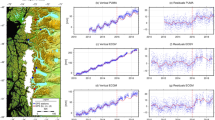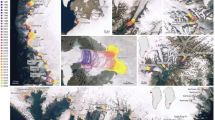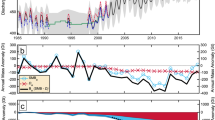Abstract
Accurate quantification of Antarctic ice-sheet mass balance and its contribution to global sea-level rise remains challenging, because in situ measurements over both space and time are sparse. Satellite remote-sensing data of ice elevations and ice motion show significant ice loss in the range of −31 to −196 Gt yr−1 in West Antarctica in recent years1,2,3,4, whereas East Antarctica seems to remain in balance or slightly gain mass1,2,4, with estimated rates of mass change in the range of −4 to 22 Gt yr−1. The Gravity Recovery and Climate Experiment5 (GRACE) offers the opportunity of quantifying polar ice-sheet mass balance from a different perspective6,7. Here we use an extended record of GRACE data spanning the period April 2002 to January 2009 to quantify the rates of Antarctic ice loss. In agreement with an independent earlier assessment4, we estimate a total loss of 190±77 Gt yr−1, with 132±26 Gt yr−1 coming from West Antarctica. However, in contrast with previous GRACE estimates, our data suggest that East Antarctica is losing mass, mostly in coastal regions, at a rate of −57±52 Gt yr−1, apparently caused by increased ice loss since the year 2006.
This is a preview of subscription content, access via your institution
Access options
Subscribe to this journal
Receive 12 print issues and online access
$259.00 per year
only $21.58 per issue
Buy this article
- Purchase on Springer Link
- Instant access to full article PDF
Prices may be subject to local taxes which are calculated during checkout




Similar content being viewed by others
References
Zwally, J. et al. Mass changes of the Greenland and Antarctic ice sheets and shelves and contributions to sea-level rise: 1992–2002. J. Glaciol. 51, 509–527 (2005).
Rignot, E. & Thomas, R. Mass balance of polar ice sheets. Science 297, 1502–1506 (2002).
Thomas, R. et al. Accelerated sea-level rise from West Antarctica. Science 306, 255–258 (2004).
Rignot, E. et al. Recent Antarctic ice mass loss from radar interferometry and regional climate modelling. Nature Geosci. 1, 106–110 (2008).
Tapley, B. D., Bettadpur, S., Watkins, M. M. & Reigber, C. The gravity recovery and climate experiment; Mission overview and early results. Geophys. Res. Lett. 31, L09607 (2004).
Velicogna, I. & Wahr, J. Measurements of time-variable gravity show mass loss in Antarctica. Science 311, 1754–1756 (2006).
Luthcke, S. B. et al. Recent Greenland ice mass loss by drainage system from satellite gravity observations. Science 314, 1286–1289 (2006).
Shepherd, A. & Wingham, D. Recent sea-level contributions of the Antarctic and Greenland ice sheets. Science 315, 1529–1532 (2007).
Davis, C. H., Li, Y., McConnell, J. R., Frey, M. M. & Hanna, E. Snowfall-driven growth in East Antarctic ice sheet mitigates recent sea-level rise. Science 308, 1898–1901 (2005).
Chen, J. L., Wilson, C. R. & Tapley, B. D. Satellite gravity measurements confirm accelerated melting of Greenland ice sheet. Science 313, 1958–1960 (2006).
Ramillien, G. et al. Interannual variations of the mass balance of the Antarctica and Greenland ice sheets from GRACE. Glob. Planet. Change 53, 198–208 (2006).
Horwath, M. & Dietrich, R. Signal and error in mass change inferences from GRACE: The case of Antarctica. Geophys. J. Int. 177, 849–864 (2009).
Wahr, J., Swenson, S., Zlotnicki, V. & Velicogna, I. Time-variable gravity from GRACE: First results. Geophys. Res. Lett. 31, L11501 (2004).
Chen, J. L., Wilson, C. R., Tapley, B. D., Blankenship, D. D. & Young, D. Antarctic regional ice loss rates from GRACE. Earth Planet. Sci. Lett. 266, 140–148 (2008).
Arendt, A. A. et al. Validation of high-resolution GRACE mascon estimates of glacier mass changes in the St Elias Mountains, Alaska, USA, using aircraft laser altimetry. J. Glaciol. 54, 778–787 (2008).
Chen, J. L., Wilson, C. R., Tapley, B. D., Blankenship, D. D. & Ivins, E. R. Patagonia icefield melting observed by gravity recovery and climate experiment (GRACE). Geophys. Res. Lett. 34, L22501 (2007).
Luthcke, S. B. et al. Proc. 2008 GRACE Science Team Meeting, 617–631 (GRACE Project, 2008).
Bettadpur, S. Level-2 Gravity Field Product User Handbook, GRACE 327–734 (GRACE Project, 2007).
Ray, R. D., Rowlands, D. D. & Egbert, G. D. Tidal models in a new era of satellite gravimetry. Space Sci. Rev. 108, 271–282 (2003).
Ivins, E. & James, T. S. Antarctic glacial isostatic adjustment: A new assessment. Antarctic Sci. 17, 541–553 (2005).
Chen, J. L., Wilson, C. R., Blankenship, D. D. & Tapley, B. D. Antarctic mass change rates from GRACE. Geophys. Res. Lett. 33, L11502 (2006).
Tregoning, P., Ramillien, G., McQueen, H. & Zwartz, D. Glacial isostatic adjustment and nonstationary signals observed by GRACE. J. Geophys. Res. 114, B06406 (2009).
Barletta, V. R., Sabadini, R. & Bordoni, A. Isolating the PGR signal in the GRACE data: Impact on mass balance estimates in Antarctica and Greenland. Geophys. J. Int. 172, 18–30 (2008).
Paulson, A., Zhong, S. & Wahr, J. Limitations on the inversion for mantle viscosity from postglacial rebound. Geophys. J. Int. 168, 1195–1209 (2007).
Peltier, W. R. Global glacial isostasy and the surface of the ice-age Earth: The ICE-5G (VM2) Model and GRACE, Invited Paper. Annu. Rev. Earth Planet. Sci. 32, 111–149 (2004).
Peltier, W. R. Closure of the budget of global sea level rise over the GRACE era: The importance and magnitudes of the required corrections for global isostatic adjustment. Quart. Sci. Rev. 28, 1658–1674 (2009).
Chen, J. L., Wilson, C. R. & Seo, K.-W. S2 tide aliasing in GRACE time-variable gravity solutions. J. Geodesy 83, 679–687 (2009).
Swenson, S. & Wahr, J. Post-processing removal of correlated errors in GRACE data. Geophys. Res. Lett. 33, L8402 (2006).
Acknowledgements
This research was supported by NASA GRACE Science Program (NNX08AJ84G), NASA PECASE award (NNG04G060G) and NSF International Polar Year Program (ANT-0632195).
Author information
Authors and Affiliations
Contributions
J.L.C. planned analyses, acquired and prepared data, implemented forward modelling and wrote the paper. C.R.W., D.B. and B.D.T. analysed the data and results.
Corresponding author
Supplementary information
Supplementary Information
Supplementary Information (PDF 916 kb)
Rights and permissions
About this article
Cite this article
Chen, J., Wilson, C., Blankenship, D. et al. Accelerated Antarctic ice loss from satellite gravity measurements. Nature Geosci 2, 859–862 (2009). https://doi.org/10.1038/ngeo694
Received:
Accepted:
Published:
Issue Date:
DOI: https://doi.org/10.1038/ngeo694
This article is cited by
-
Estimation of groundwater storage change in the Helmand River Basin (Afghanistan) using GRACE satellite data
Earth Science Informatics (2023)
-
Filling the gap between GRACE and GRACE-FO data using a model integrating variational mode decomposition and long short-term memory: a case study of Northwest China
Environmental Earth Sciences (2023)
-
A comprehensive assessment and analysis of Antarctic satellite grounding line products from 1992 to 2009
Science China Earth Sciences (2021)
-
Common Mode Component and Its Potential Effect on GPS-Inferred Crustal Deformations in Greenland
Pure and Applied Geophysics (2021)
-
GRAMAT: a comprehensive Matlab toolbox for estimating global mass variations from GRACE satellite data
Earth Science Informatics (2019)



